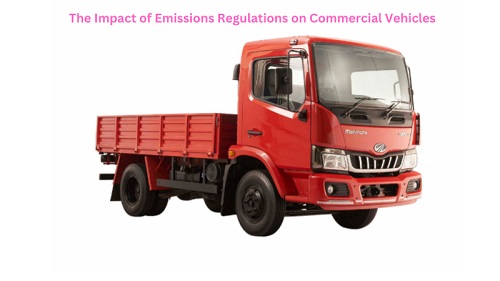The Impact of Emissions Regulations on Commercial Vehicles

In recent decades, concern over environmental issues and climate change is increasing. Also, several industries have resulted in the introduction of strict emission regulations. In the trucking market, Mahindra Truck holds a significant position. It has led the charge in implementing measures to adhere to these rules. The commercial vehicles transportation sector may bear a major share of the blame for emissions. That is the reason these regulations have made it a major priority.
Industries intend to reduce their carbon footprint and combat air pollution. Since then, emission regulations for commercial trucks have evolved and intensified.
Let’s explore the multifaceted impact of emission regulations on commercial trucks.
A Sustainable Future : Emission Control in Commercial Vehicles
Emission control in commercial vehicles, including trucks, is pivotal in shaping a sustainable future. Stricter regulations demand cleaner and more efficient engines, fostering innovation.
Besides reducing harmful emissions, it drives cost-efficiency through fuel savings. Moreover, the rural regions benefit from cleaner air and more eco-friendly transportation.
Furthermore, technological advancements, such as electric and hybrid trucks, offer promising solutions.
Also, embracing these changes ensures compliance and contributes to a greener environment. Thus trucks promote a sustainable future through effective emission control measures.
Technological Advancements
The implementation of emission regulations has driven significant technological advancements. These advancements appear in the design and engineering of commercial trucks. Manufacturers must develop innovative solutions to meet these stringent requirements:
- Diesel Particulate Filters (DPF)
DPF technology has become a standard in modern trucks. These filters capture and eliminate particulate matter, ensuring cleaner exhaust emissions.
- Selective Catalytic Reduction (SCR)
SCR systems inject a urea-based solution into the exhaust stream, reducing NOx emissions. This technology has become crucial for meeting Tier 4 Final standards.
- Advanced Engine Control Systems
Modern trucks have powerful engine systems that optimize fuel combustion and reduce emissions. These systems monitor various parameters and make real-time efficiency and emission control adjustments.
- Lightweight Materials
Truck manufacturers have turned to lightweight materials like aluminium and composites. As a result, it improves fuel efficiency and reduces emissions. It thereby decreases emissions and increases fuel efficiency. Additionally, it lessens the vehicle’s total weight.
- Hybrid and Electric Trucks
As sustainability becomes a priority, there’s a growing interest in hybrid and electric trucks. These vehicles produce zero tailpipe emissions to lower the carbon footprint of commercial trucks. Further, they are seen as a long-term solution for the trucking industry.
Economic Implications
Emission regulations have undeniable economic implications for the commercial trucking industry. While the initial costs of compliance can be significant, there are both short-term and long-term economic benefits:
- Initial Costs
Meeting emission standards often requires investments in new technologies and equipment, which can increase the upfront cost of purchasing commercial trucks. However, over time, fuel savings and reduced maintenance expenses tend to offset these costs.
- Fuel Efficiency
Emission regulations have driven improvements in fuel efficiency, leading to cost savings for trucking companies. Moreover efficient trucks consume less fuel, reducing operational expenses.
- Maintenance Savings
Modern trucks equipped with advanced emission control systems require less maintenance. Fewer breakdowns and repairs result in lower maintenance costs.
- Market Access
Compliance with emission regulations allows trucking companies to access markets with strict environmental standards. Non-compliant vehicles may be restricted or subject to additional fees and penalties.
- Global Competitiveness
Being at the forefront of emission-reducing technologies positions manufacturers and trucking companies as competitive players in a rapidly evolving trucking market.
Future of Green Trucking
The future of the commercial trucking industry is intrinsically linked to green and sustainable practices. Emission regulations will continue to evolve, pushing the industry toward greater eco-friendliness:
- Stricter Standards:
Emission standards will continue to tighten globally, focusing on reducing NOx and greenhouse gas emissions. This will drive further innovation in clean technologies.
- Alternative Fuels:
Adopting alternative fuels like natural gas, hydrogen, and electricity will grow. Also, these options offer zero-emission transportation solutions.
- Autonomous and Connected Trucks:
Connectivity and autonomous technologies help improve fuel efficiency and reduce emissions. These innovations will optimize routes, reduce idle time, and enhance fleet management.
- Sustainable Logistics:
Companies will increasingly adopt sustainable logistics practices, such as route optimization, efficient loading, and emissions tracking, to reduce their carbon footprint.
- Government Incentives:
Official governments will continue to offer incentives and subsidies for purchasing eco-friendly trucks. It promotes the adoption of greener technologies in the industry.
The Bottom Line
Emission regulations have transformed the commercial trucking industry. Moreover, it drives technological advancements, promoting fuel efficiency and reducing harmful emissions. For instance, Tata Motors Truck. promises reliable and emission-free business operations.
The initial costs and challenges of compliance are notable. Besides, the long-term commitment to a cleaner environment makes the transition worthwhile.
As emission standards continue to evolve, the trucking industry continues to shape a more sustainable future. Meeting these standards is more than just a regulatory requirement. Besides, it’s committed to reducing the industry’s environmental impact and creating a greener, healthier world.


